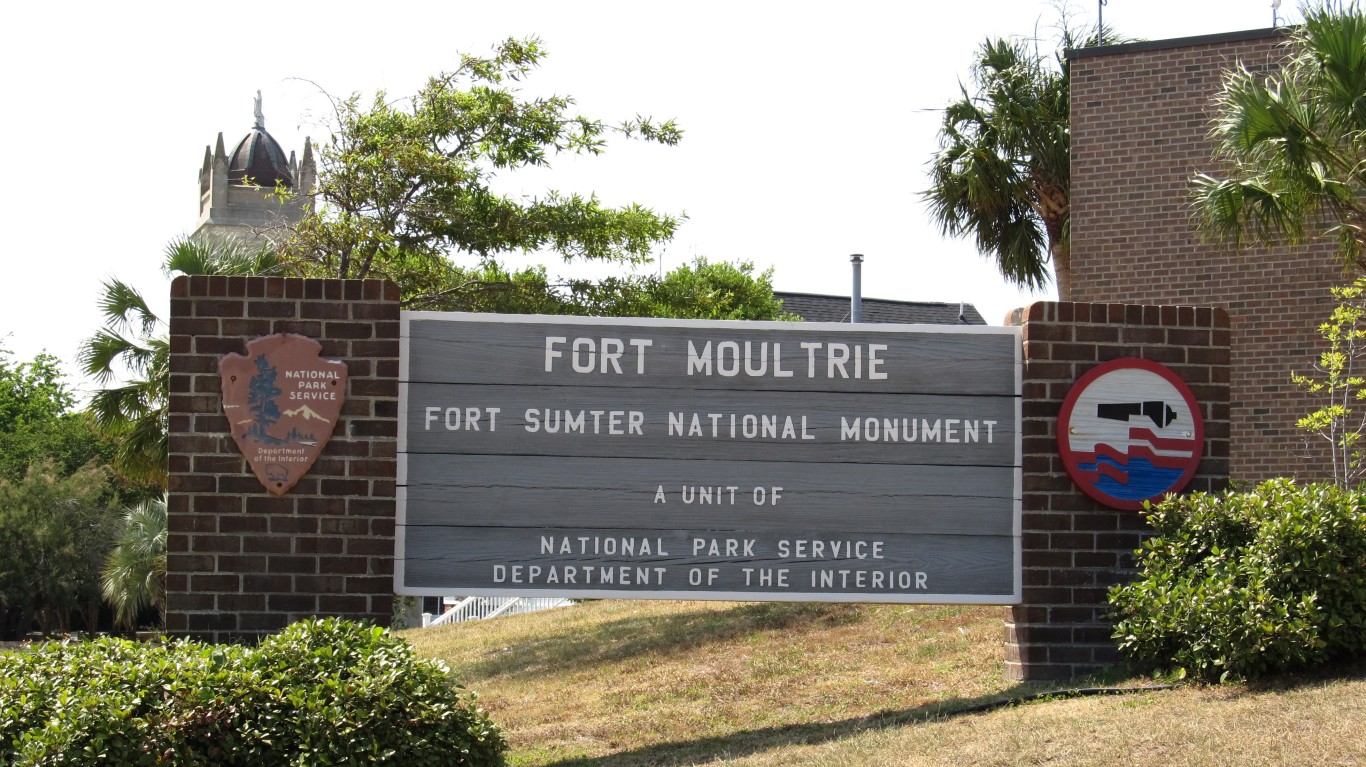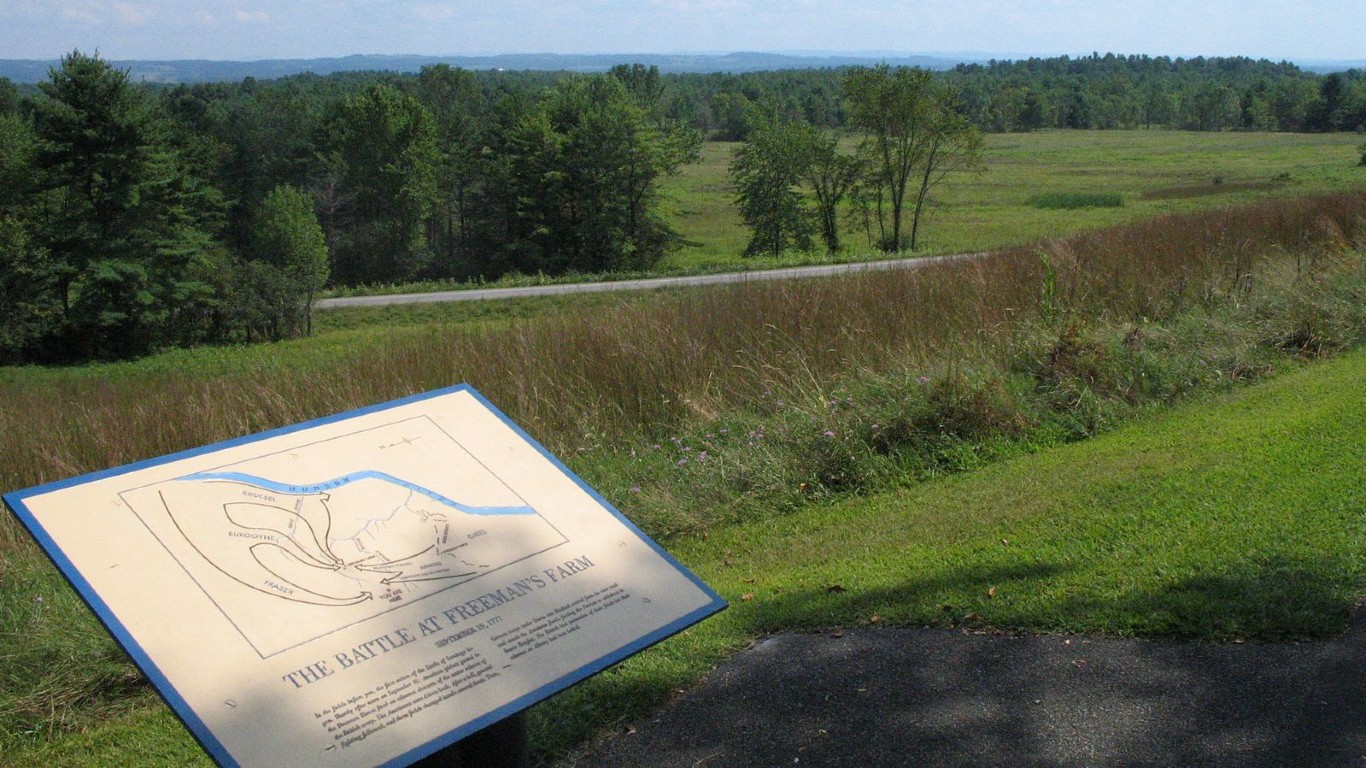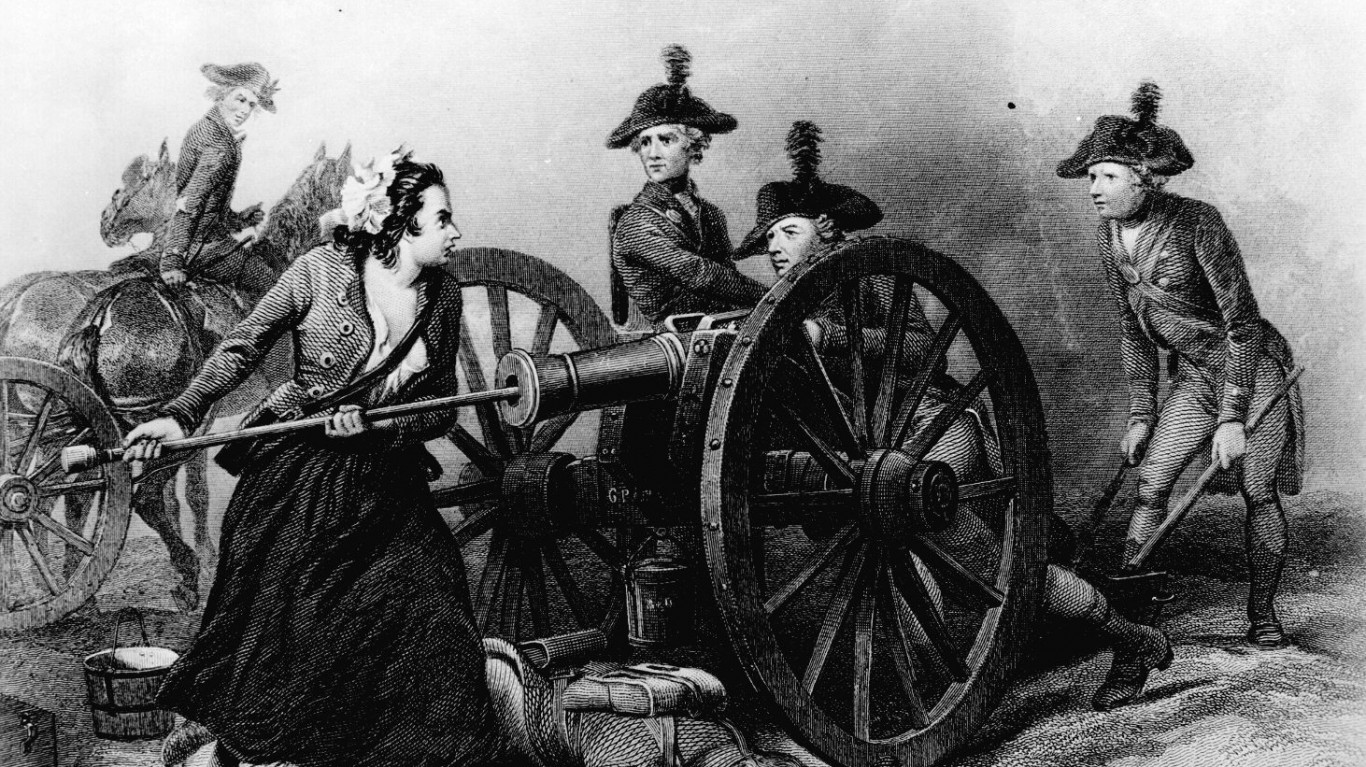
When hostilities commenced during the American Revolution in 1775 between Great Britain and the North American colonies, all the advantages seemed to be on the side of Great Britain, the largest empire in the world. For the next eight years, the two sides were locked in combat up and down the Eastern Seaboard that ultimately resulted in the defeat of the British Empire and the formation of the United States of America.
24/7 Tempo has compiled a list of the largest battles of the Revolutionary War. We based our list of engagements that involved at least 1,000 soldiers on each side. Among the sources we used in compiling our list were revolutionary-war.net, battlefields.org, and britannica.org.
The Royal Navy, which was without equal at the time, allowed the British to capture and occupy coastal cities like Philadelphia and New York relatively early in the conflict. However, their relatively small land army, though professionally trained and augmented with Hessian mercenaries — German troops hired by the British to join the army — was not able to control the countryside, where 90% of the colonial population lived.
Most of the early major combat took place in New England and the Northeastern states. The British put the colonists on the backfoot with victories in Long Island and Manhattan in New York, and successes at Brandywine and Germantown in Pennsylvania. But overall success in the north eluded them. The British strategy of dividing the northern colonies failed, culminating in the loss at Saratoga that brought the French into the war.
Great Britain shifted its strategy to the south where it believed it had more Loyalist support. The strategy seemed effective as British fortunes improved at first. They thwarted a siege of Savannah, and emerged victorious in battles at Charleston and Camden, South Carolina. But their biggest loss in the south, the siege of Yorktown, was the final major battle of the war, and led to peace talks that would pave the way for the creation of the United States.
Click here to see the 31 largest battles of the American Revolutionary War

Bunker Hill, Massachusetts
> Date: June 17, 1775
> Combatants: American: 2,400; British: 3,000
The Battle of Bunker Hill took place on June 17, 1775, during the early stages of the American Revolutionary War. It occurred on the outskirts of Boston, Massachusetts. The colonial forces, despite being outnumbered, put up a fierce resistance against the British troops. Eventually, due to a lack of ammunition, they had to retreat. Although the British won the battle, they suffered heavy casualties — more than 200 killed and over 800 wounded — which boosted the morale of the colonial forces and showed that they were a formidable opponent.
[in-text-ad]
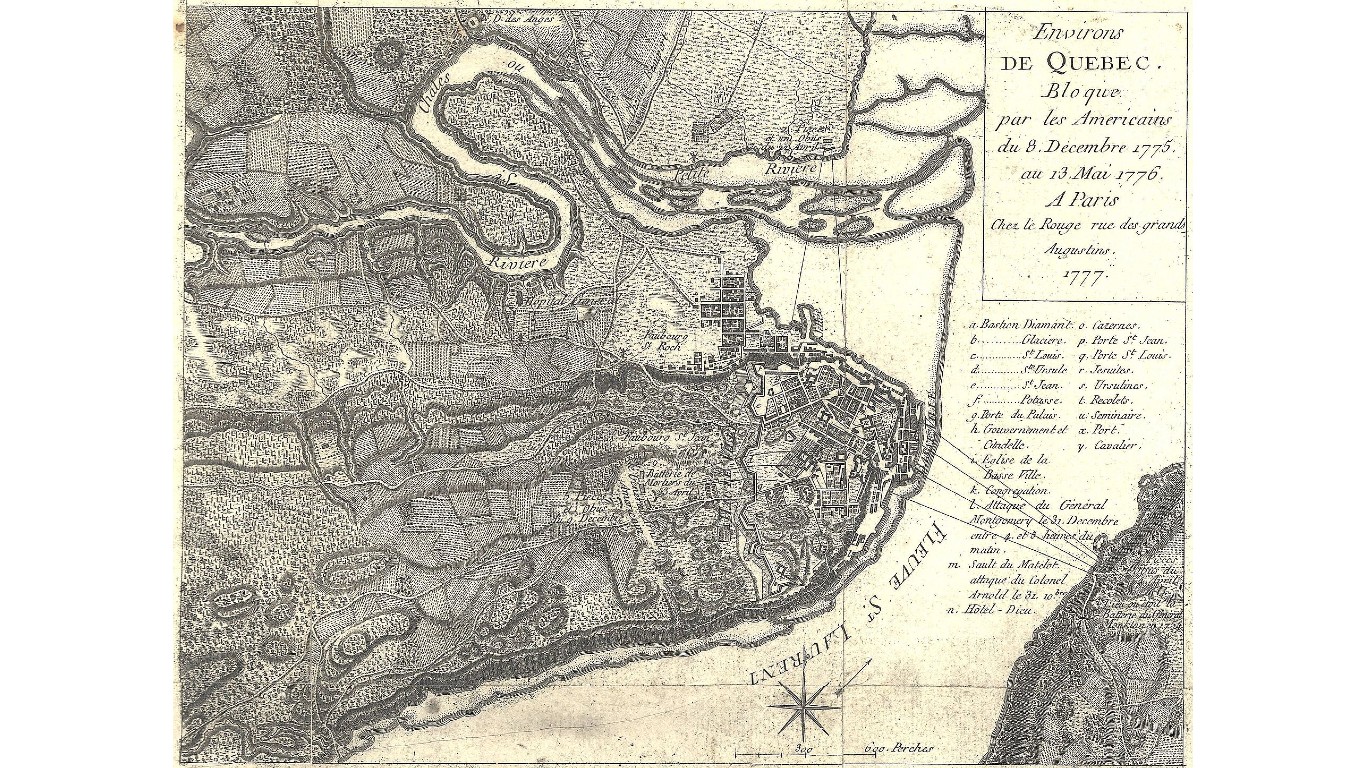
Quebec, Canada
> Date: Dec. 31, 1775
> Combatants: American: 1,200; British: 1,200
The Battle of Quebec was a failed attempt by American forces to capture the British-occupied city of Quebec in Canada early in the Revolutionary War. Led by General Richard Montgomery, the American colonists launched a surprise attack on the British-occupied city. Harsh winter conditions and strong British defenses proved too great a challenge, as the battle resulted in heavy American casualties, including the death of Montgomery. The American forces were forced to retreat, marking the first major setback of the war for the Americans.

Moore’s Creek Bridge, North Carolina
> Date: Feb, 27, 1776
> Combatants: American: 1,050; British: 1,000
The Battle of Moore’s Creek Bridge was a significant victory for the American colonial forces. The battle occurred when loyalist forces, supporting British rule, attempted to cross Moore’s Creek Bridge to join British troops in the South. The American revolutionaries set up an ambush. They successfully defended the bridge, leading to a decisive victory. The battle crippled loyalist support in the region and helped solidify the colonists’ defense against the British in North Carolina.

Trois-Rivières, Canada
> Date: June 8, 1776
> Combatants: American: 2,000; British: 1,000
British forces, led by General Guy Carleton, successfully defended the strategically beneficial Canadian town of Trois-Rivières against an American invasion. The American troops, commanded by General Benedict Arnold, sustained heavy casualties and were forced to retreat. This engagement proved to be a significant setback for the American forces, as it limited their ability to advance further into Canada and secure additional support for the Revolution.
[in-text-ad-2]
Sullivan’s Island, South Carolina
> Date: June 28, 1776
> Combatants: American: 6,700; British: 4,500
British forces, under the command of Sir Peter Parker, launched an attack on Sullivan’s Island in South Carolina, where Colonel William Moultrie led a naval defense of some 6,700 American troops. The Americans successfully repelled the assault — 10 Royal Navy warships and 2,500 British troops — marking the first decisive American victory over the British Navy. The British fleet suffered significant damage and casualties, forcing them to abandon their efforts to capture the island.
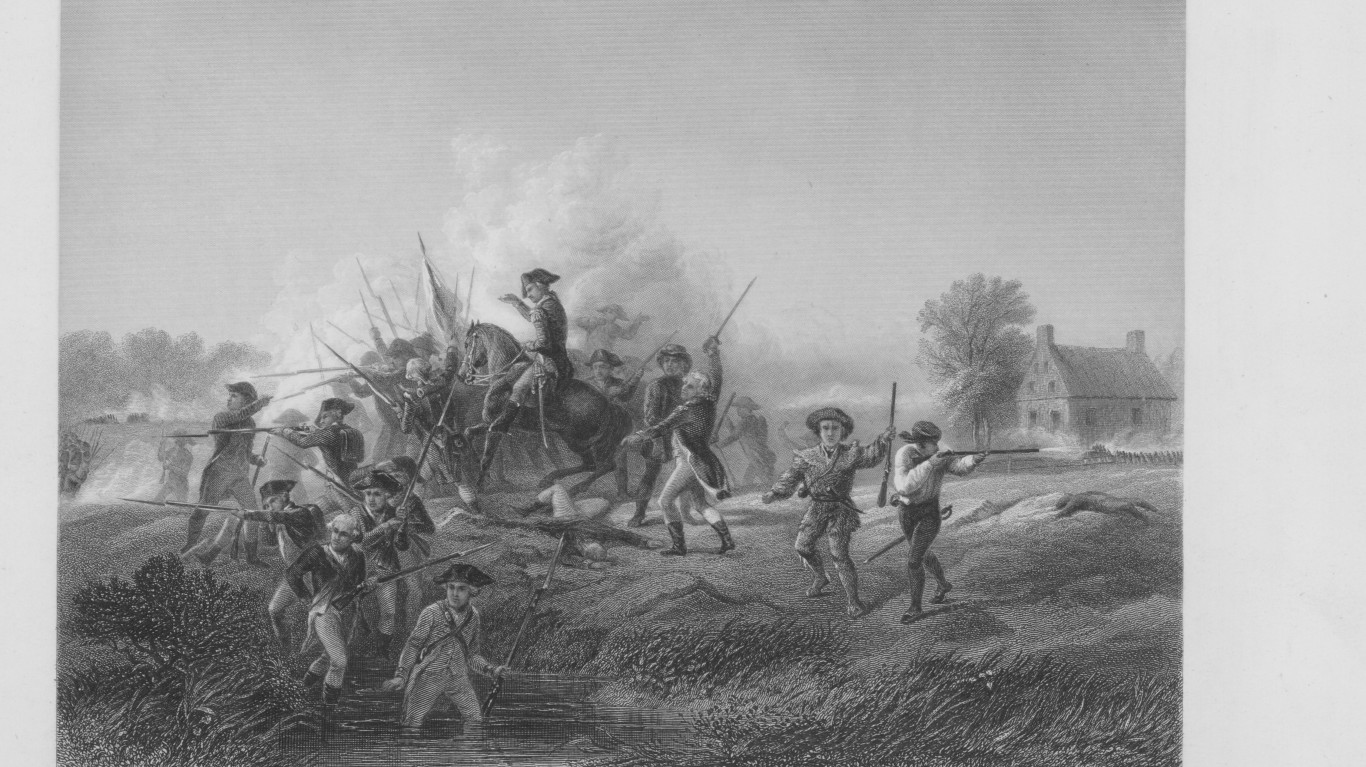
Long Island, New York
> Date: Aug. 27-29, 1776
> Combatants: American: 10,000; British: 20,000
The Battle of Long Island is also known as the Battle of Brooklyn. British forces launched an assault on American troops in Long Island, New York, a little over a year after the start of the war. The Americans, led by General George Washington, were outnumbered and outflanked, sustaining heavy casualties when they were forced to retreat, crossing the East River to Manhattan. The victory allowed the British to gain control of New York City and establish a foothold in the region.
[in-text-ad]
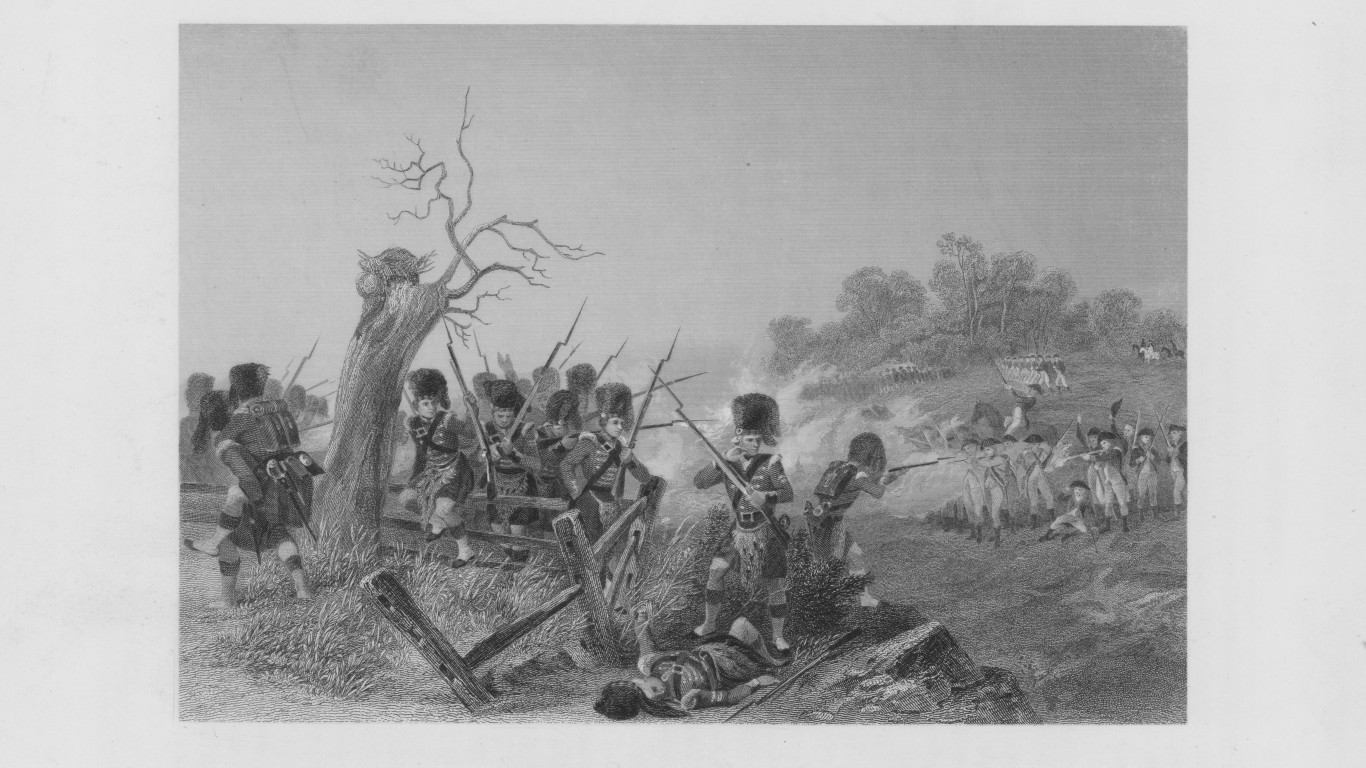
Harlem Heights, New York
> Date: Sept. 16, 1776
> Combatants: American: 1,800; British: 1,600
In the morning of September 16, 1776, British General William Howe led an attack on the American Continental Army near Harlem Heights in New York. The American forces, after its recent defeat at the Battle of Long Island the previous month, successfully repelled the British attacks.

White Plains, New York
> Date: Oct. 28, 1776
> Combatants: American: 3,100; British: 4,000-7,500
While inflicting a heavy toll on the British, the Battle of White Plains ended in defeat for the Americans. George Washingon and the Continental Army gave up their position in White Plains following a series of defeats as the Americans had ceded New York City to the British earlier that summer. Washington continued a strategic retreat to New Jersey. Although the battle resulted in a British victory, the American forces avoided major losses and preserved their army for future battles.
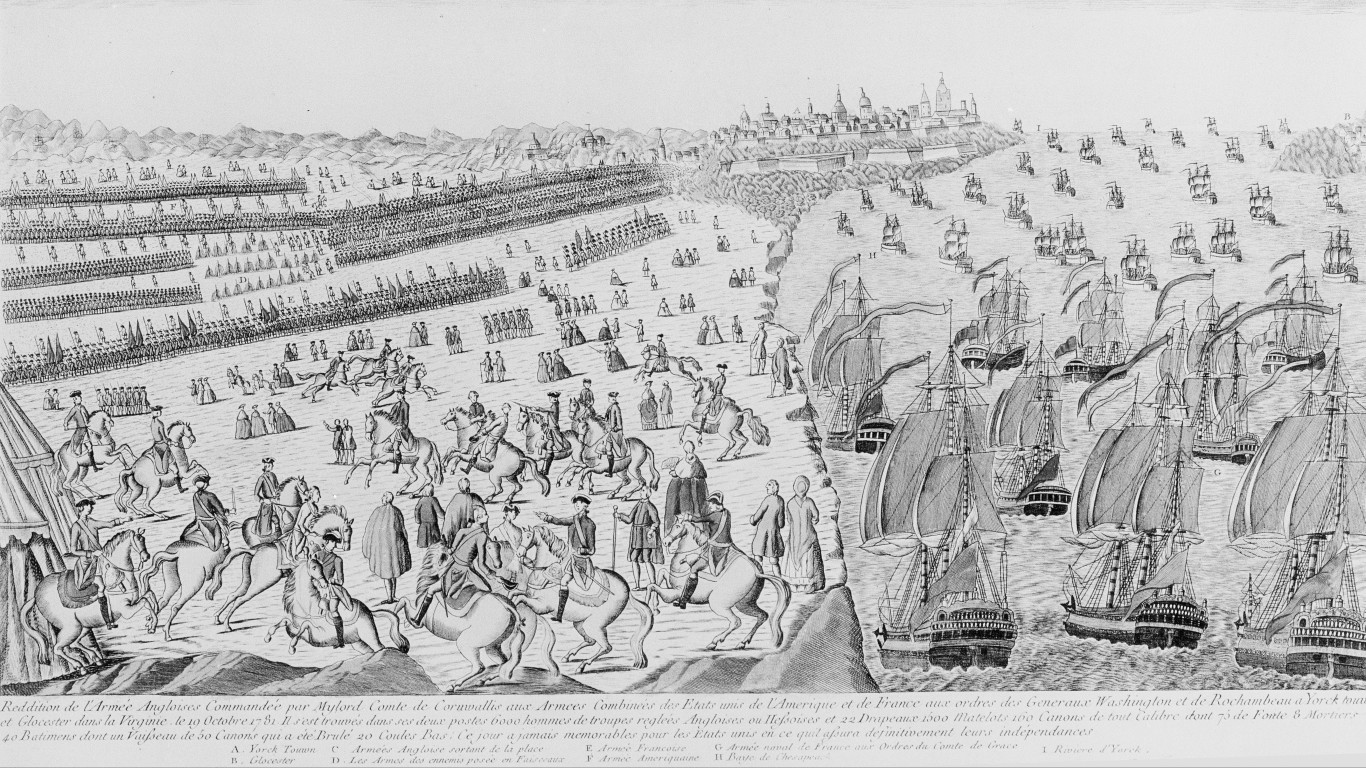
Fort Washington, New York
> Date: Nov. 16, 1776
> Combatants: American: 3,000; British: 8,000
British forces, commanded by General William Howe, launched an assault on Fort Washington, located on the northern end of Manhattan Island in New York. The fort, under the command of General Nathanael Greene and Colonel Robert Magaw, was a pentagonal earthwork position without ditches or palisades. It also lacked an interior source of water.
Despite fierce resistance, the American defenders were overwhelmed by the superior British forces. The capture of Fort Washington allowed the British to gain control over New York City, furthering Howe’s goal of completely removing American troops from Manhattan.
[in-text-ad-2]

Fort Lee, New Jersey
> Date: Nov. 20, 1776
> Combatants: American: 2,000; British: 4,000
Fort Lee was situated on the New Jersey side of the Hudson River, opposite Fort Washington. A line of sunken obstructions ran between the two forts to prevent British ships from passing up the river. After the capture of Fort Washington, the British prepared a coordinated attack on nearby Fort Lee, including a force led by General Charles Cornwallis.
The Americans were forced to abandon Fort Lee, and Washington would soon decide to set up winter headquarters in New Jersey. The recent defeats resulted in heavy losses for the already under-supplied US Colonies. The British seized 146 cannons, 12,000 shot and shell, 2,800 muskets, and 400,000 cartridges.

Trenton, New Jersey
> Date: Dec. 26, 1776
> Combatants: American: 2,400; British: 3,000
In the winter of 1776, American forces, led by General George Washington, launched a surprise attack on a Hessian army stationed in Trenton, New Jersey. “Hessian” refers to German troops hired by the British during the war.
The Hessians, under the command of Colonel Johann Rall, were caught off guard. The Americans achieved a decisive victory, capturing over two-thirds of the Hessians and suffering minimal casualties. The Battle of Trenton provided a much-needed boost to American morale and demonstrated Washington’s strategic acumen. It also reinvigorated the Revolutionary cause, encouraging more enlistments and support from the local population.
[in-text-ad]
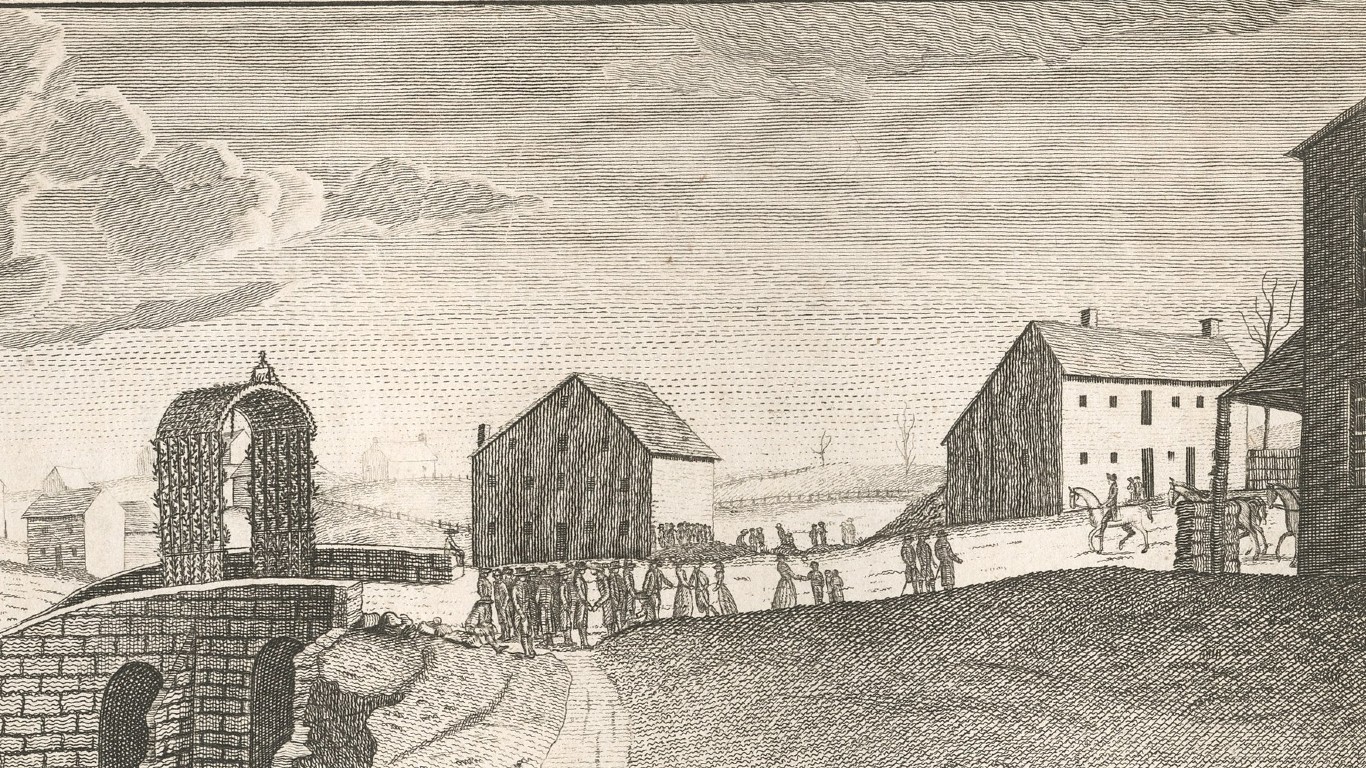
Assunpink Creek, New Jersey
> Date: Jan. 2-3, 1777
> Combatants: American: 6,000; British: 8,000
The Battle of Assunpink Creek is also known as the Second Battle of Trenton. British troops under the leadership of Lieutenant General Charles Cornwallis attacked American forces near Assunpink Creek in New Jersey. The Americans, strategically positioned along the creek, successfully repelled several British attacks. Eventually, under the cover of darkness, Washington’s forces successfully withdrew from the battlefield, evading a potentially devastating defeat. Washington’s audacious counterattack shattered British forces, capturing 200 soldiers and inflicting light casualties.

Bennington, Vermont
> Date: Aug. 16, 1777
> Combatants: American: 3,000; British: 1,450
American forces, led by General John Stark, engaged British and German troops commanded by Colonel Friedrich Baum near Bennington, Vermont. Militia and Continental soldiers decisively defeated the British forces after heavy fighting. The victory at Bennington was a significant turning point as it disrupted British plans and secured crucial supplies for the Continental Army.

Brandywine, Pennsylvania
> Date: Sept. 11, 1777
> Combatants: American: 14,600; British: 15,500
Despite a valiant defense, the American forces were outflanked and suffered a defeat in Brandywine. The British victory allowed them to advance and capture Philadelphia, the capital of the North American colonies at the time. In order to avoid a complete catastrophe, Washington directed Nathanael Greene’s division to serve as a protective force, allowing the Continental Army to safely retreat towards the northeast.
[in-text-ad-2]
Freeman’s Farm, New York
> Date: Sept. 19, 1777
> Combatants: American: 6,000; British: 7,200
The Battle of Freeman’s Farm, one of the longest land battles of the American Revolutionary War, is also known as the First Battle of Saratoga. American forces, led by General Horatio Gates, clashed with British troops commanded by General John Burgoyne near Freeman’s Farm in New York.
The battle was part of a larger campaign to control the Hudson River. Though both sides suffered heavy casualties, the engagement ended inconclusively. Both armies maintained their camps without significant movement for the following three weeks until they clashed once more at the Battle of Bemis Heights.

Paoli, Pennsylvania
> Date: Sept. 20, 1777
> Combatants: American: 2,500; British: 1,200
The Battle of Paoli is also known as the Paoli Massacre. The British launched a surprise nighttime assault, emerging from the woods, resulting in a brutal and one-sided engagement. The Americans suffered heavy casualties and were unable to mount an effective defense. The Battle of Paoli was a devastating defeat for the American forces, leaving a lasting impact on the Revolutionary War in Pennsylvania. General Anthony Wayne, who commanded the Continental troops, was brought up on charges of misconduct, but was found not guilty.
[in-text-ad]

Germantown, Pennsylvania
> Date: Oct. 4, 1777
> Combatants: American: 11,000; British: 9,000
The Americans launched a surprise attack just outside Philadelphia, but encountered difficulties due to fog and confusion. Washington was planning to destroy the British detachment at Germantown using a double envelopment maneuver. Despite initial setbacks, the British prevailed and the Americans were forced to retreat. The battle did not significantly change the strategic positions of either army.
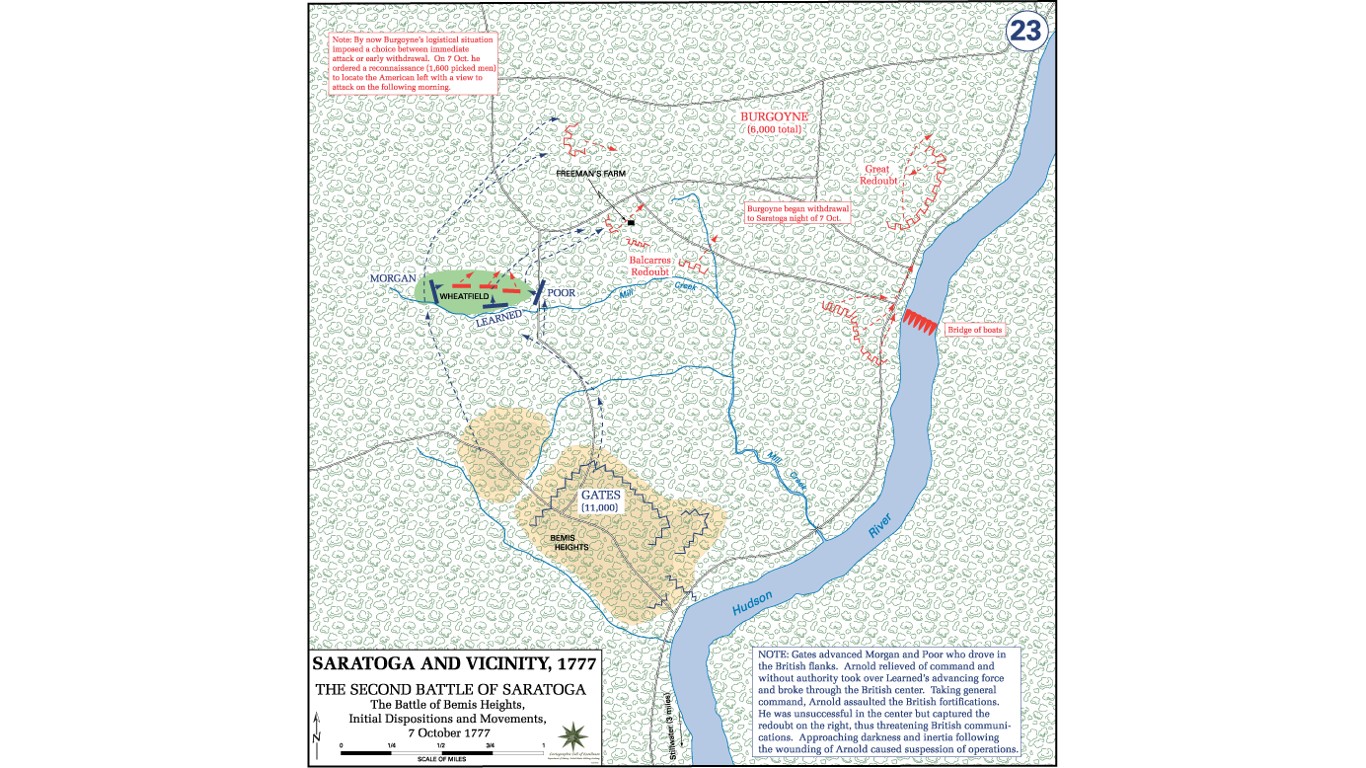
Bemis Heights-New York
> Date: Oct. 7, 1777
> Combatants: American: 12,000; British: 6,600
The battle of Bemis Heights, near Saratoga, New York ended in the first British surrender in world history. Led by General Horatio Gates, the Americans defeated British forces commanded by General John Burgoyne. The battle played a crucial role in turning the tide of the war, as the victory by the North American colonists convinced France to formally ally with the American cause.
Monmouth-New Jersey
> Date: June 28, 1778
> Combatants: American: 14,300; British: 17,660
The battle of Monmouth took place near present-day Freehold Borough on an extremely hot day, with both sides initially experiencing tactical ups and downs. However, the Americans ultimately held their ground and forced the British to withdraw during the night. The battle, which took place three years into the war but still long before its end, showcased the growth in discipline and training of the Continental Army.
[in-text-ad-2]
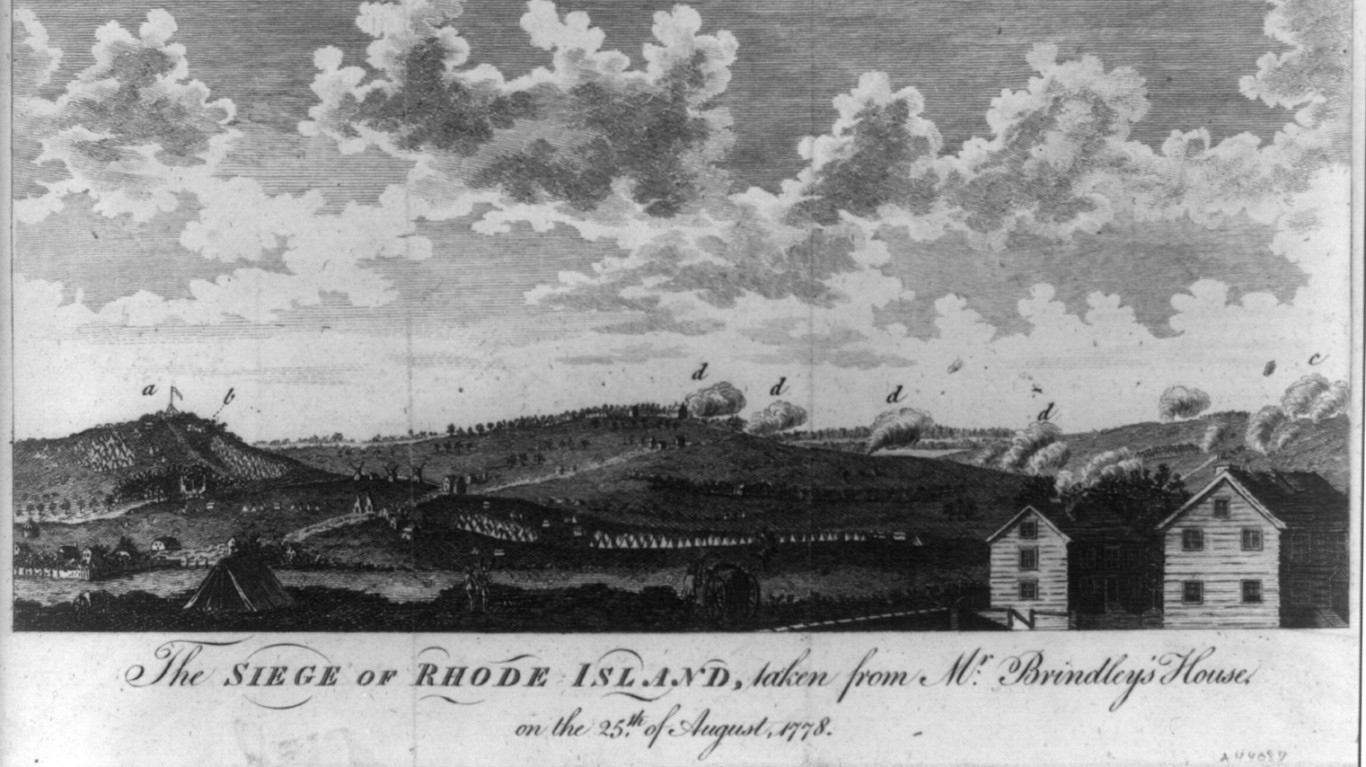
Rhode Island
> Date: Aug. 29, 1778
> Combatants: American: 10,100; British:7,000
The Battle of Rhode Island occurred near Newport. It involved, for the first time, a combined force of American and French troops, led by General John Sullivan and General Marquis de Lafayette, against the British garrison under General Sir Robert Pigot.
The battle was part of an attempt by the Americans to recapture Newport from British control. The attack did not succeed, largely because of high winds and rain, and ended in the British maintaining their position.
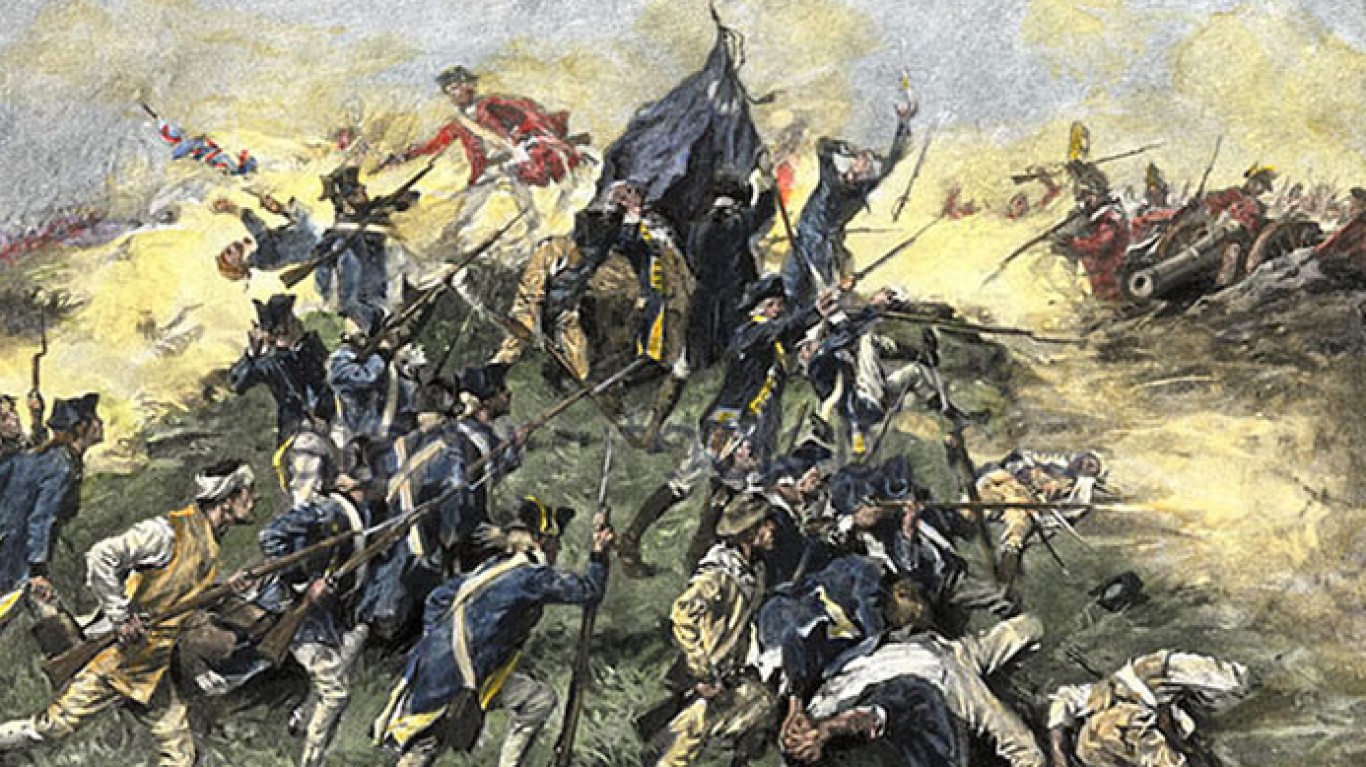
Savannah, Georgia
> Date: Sept. 16-Oct. 18, 1779
> Combatants: American: 5,500; British: 3,200
The Siege of Savannah involved an attempt by American and French forces, led by General Benjamin Lincoln and Admiral Charles-Henri d’Estaing, to capture the city from the British defenders commanded by General Augustine Prevost. The siege consisted of a series of assaults and bombardments on the British fortifications, but ultimately failed. The American and French forces suffered heavy losses and were forced to abandon their attempts to retake the port city.
[in-text-ad]
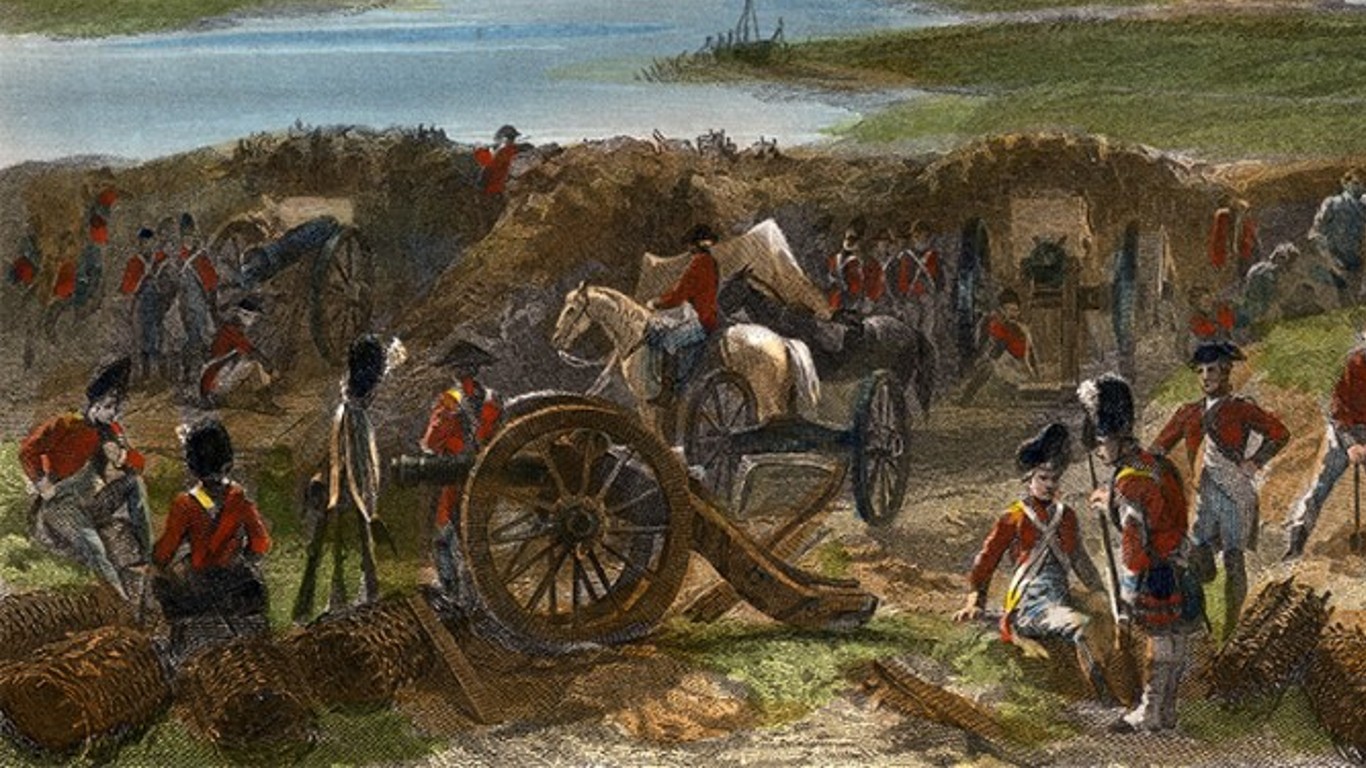
Charleston, South Carolina
> Date: March 29-May 12, 1780
> Combatants: American: 6,577; British: 17,347
British forces, led by General Sir Henry Clinton, launched a siege against the city, which was defended by American troops commanded by General Benjamin Lincoln. The British bombardment inflicted heavy damage on Charleston’s defenses, leading to the surrender of the American forces on May 12, 1780.
The capture of Charleston was a significant victory for the British, as it provided them with a strategic stronghold in the southern colonies and severely weakened the American cause in the region.
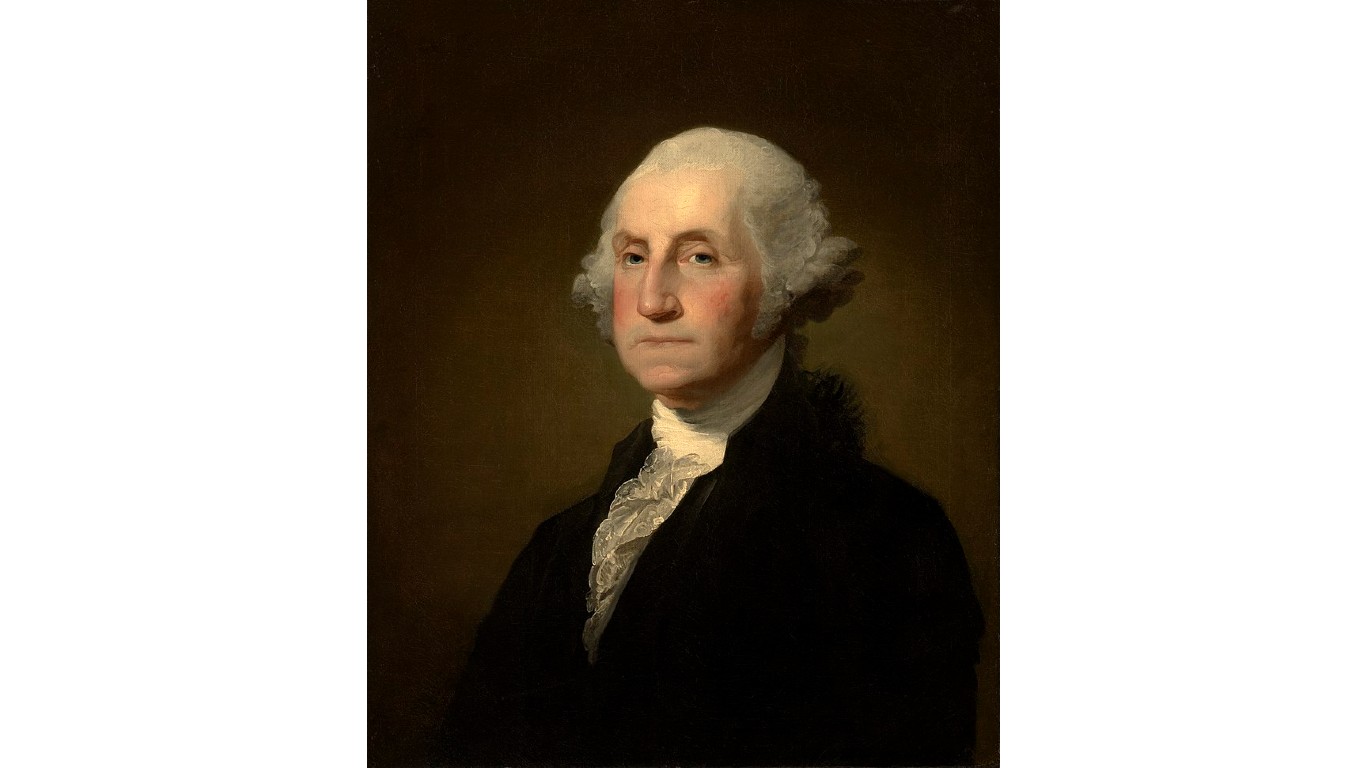
Connecticut Farms, New Jersey
> Date: June 7, 1780
> Combatants: American: 5,000; British: 6,000
The battle marked one of the final significant encounters of the Revolutionary War, and formed a crucial part of General Washington’s defensive measures against the second British invasion of New Jersey.
The British launched an assault on the Connecticut Farms village, which triggered fierce resistance from the American troops. Consequently, the village suffered extensive destruction.
Camden, South Carolina
> Date: Aug. 16, 1780
> Combatants: American: 3,700; British: 2,230
British forces, led by General Charles Cornwallis, engaged American troops commanded by General Horatio Gates. The battle ended in a resounding victory for the British, with the American forces suffering heavy casualties and loss of position. The defeat resulted in the elimination of organized American resistance in South Carolina, allowing Lord Cornwallis to proceed with his invasion of North Carolina.
[in-text-ad-2]
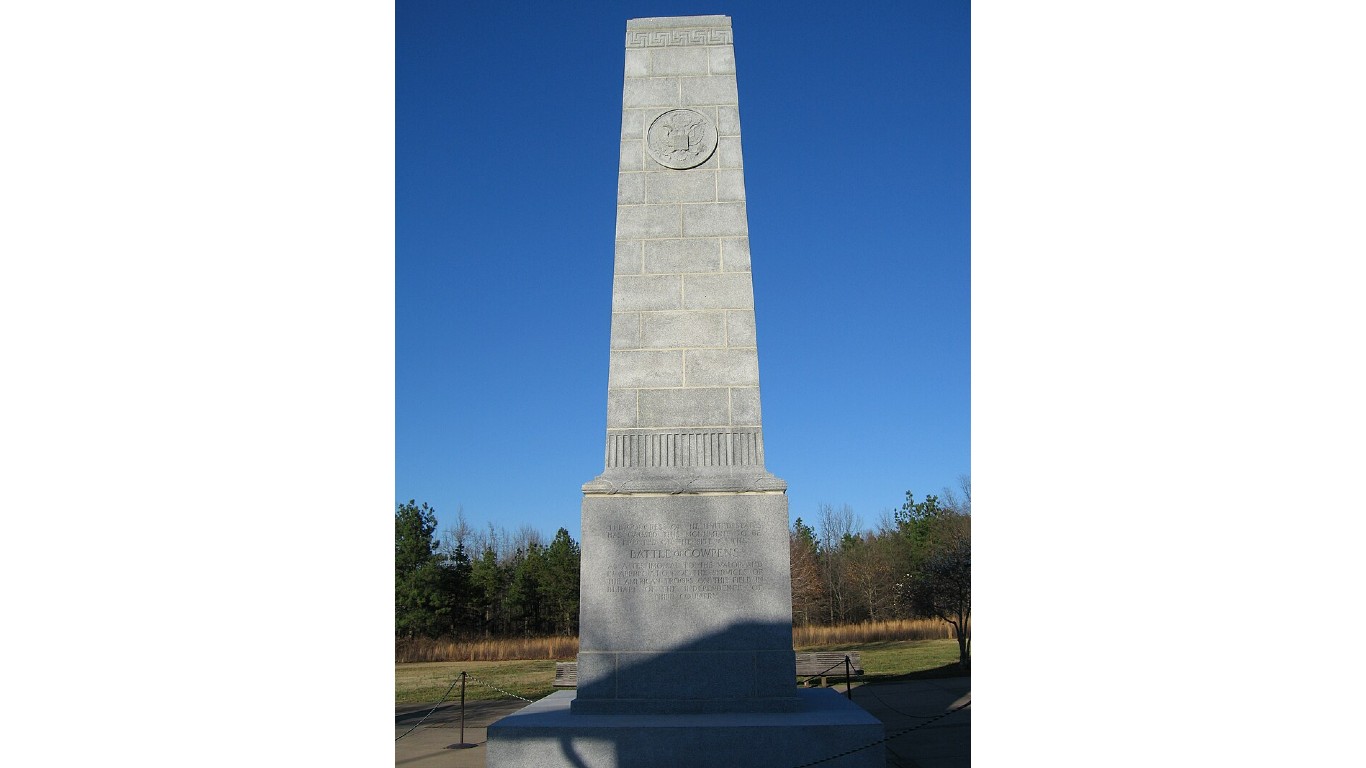
Cowpens, South Carolina
> Date: Jan. 17, 1781
> Combatants: American: 1,065; British: 1,150
American forces faced British troops commanded by Colonel Banastre Tarleton. The battle resulted in a decisive victory for the Americans, who skillfully executed a tactical maneuver known as a double envelopment — an attack on two sides of an army formation.
The British suffered significant casualties and were forced to retreat. The Battle of Cowpens boosted American morale, weakened British forces in the South, and played a pivotal role in the ultimate American victory in the Revolutionary War.

Guilford Court House, North Carolina
> Date: March 15, 1781
> Combatants: American: 4,400; British: 2,385
The Battle of Guilford Court House marked a turning point in the Southern campaign.
Although the British technically won the battle, it was seen as a Pyrrhic victory as Lord Cornwallis suffered heavy casualties and his army was significantly weakened. He was forced to relocate his forces to Virginia. The American forces also withdrew, preserving their army for future engagements.
[in-text-ad]

Blandford, Virginia
> Date: April 25, 1781
> Combatants: American: 1,000; British: 2,500
British forces, led by General William Phillips, attacked the town of Blandford, which was occupied by American troops under the command of General Peter Muhlenberg. Despite being outnumbered, the American troops put up a strong resistance against the advancing British forces and skillfully executed a disciplined retreat across the Appomattox River, successfully evading the enemy’s attempt to flank them. Eventually, the American defense held, inflicting heavy casualties and forcing the British to retreat.
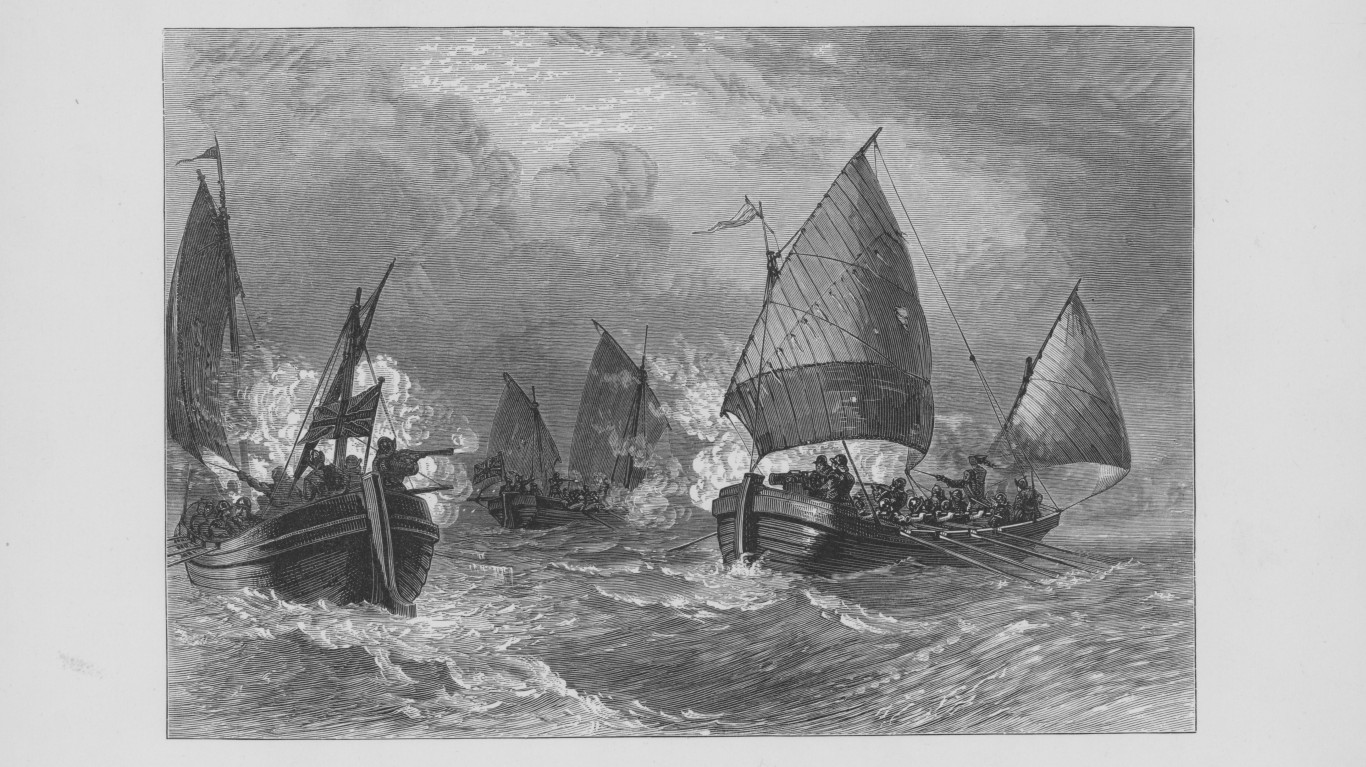
Chesapeake, Virginia
> Date: Sept. 5, 1781
> Combatants: French ships: 24; British ships: 19
The naval battle of Chesapeake had high stakes for the British as the Royal Navy used the Chesapeake Bay to transport reinforcements. The battle featured the French fleet, led by Admiral de Grasse, engaging the British fleet under Admiral Thomas Graves. The French victory secured control of the bay, denying British reinforcements and leading to the successful siege and surrender of General Cornwallis at Yorktown.
Eutaw Springs, South Carolina
> Date: Sept. 8, 1781
> Combatants: American: 2,200; British: 2,000
The battle resulted in heavy casualties on both sides, but the Americans successfully held their ground and forced the British to retreat. The British’s endeavor to pacify the South by garnering support from Loyalists had already faltered even prior to Cornwallis’s surrender at Yorktown.
[in-text-ad-2]
Siege of Yorktown, Virginia
> Date: Sept. 28-Oct. 19, 1781
> Combatants: American/French: 19,900; British: 9,000
The battle was a decisive engagement in which combined American and French forces, led by General George Washington and General Jean-Baptiste de Rochambeau, laid siege to British forces commanded by General Lord Cornwallis. The siege resulted in Cornwallis’s surrender. It effectively led to the recognition of American independence and paved the way for the eventual end of the Revolutionary War. The Siege of Yorktown marked the final significant land battle of the American Revolutionary War fought on North American soil.
It’s Your Money, Your Future—Own It (sponsor)
Are you ahead, or behind on retirement? For families with more than $500,000 saved for retirement, finding a financial advisor who puts your interest first can be the difference, and today it’s easier than ever. SmartAsset’s free tool matches you with up to three fiduciary financial advisors who serve your area in minutes. Each advisor has been carefully vetted and must act in your best interests. Start your search now.
If you’ve saved and built a substantial nest egg for you and your family, don’t delay; get started right here and help your retirement dreams become a retirement reality.
Thank you for reading! Have some feedback for us?
Contact the 24/7 Wall St. editorial team.
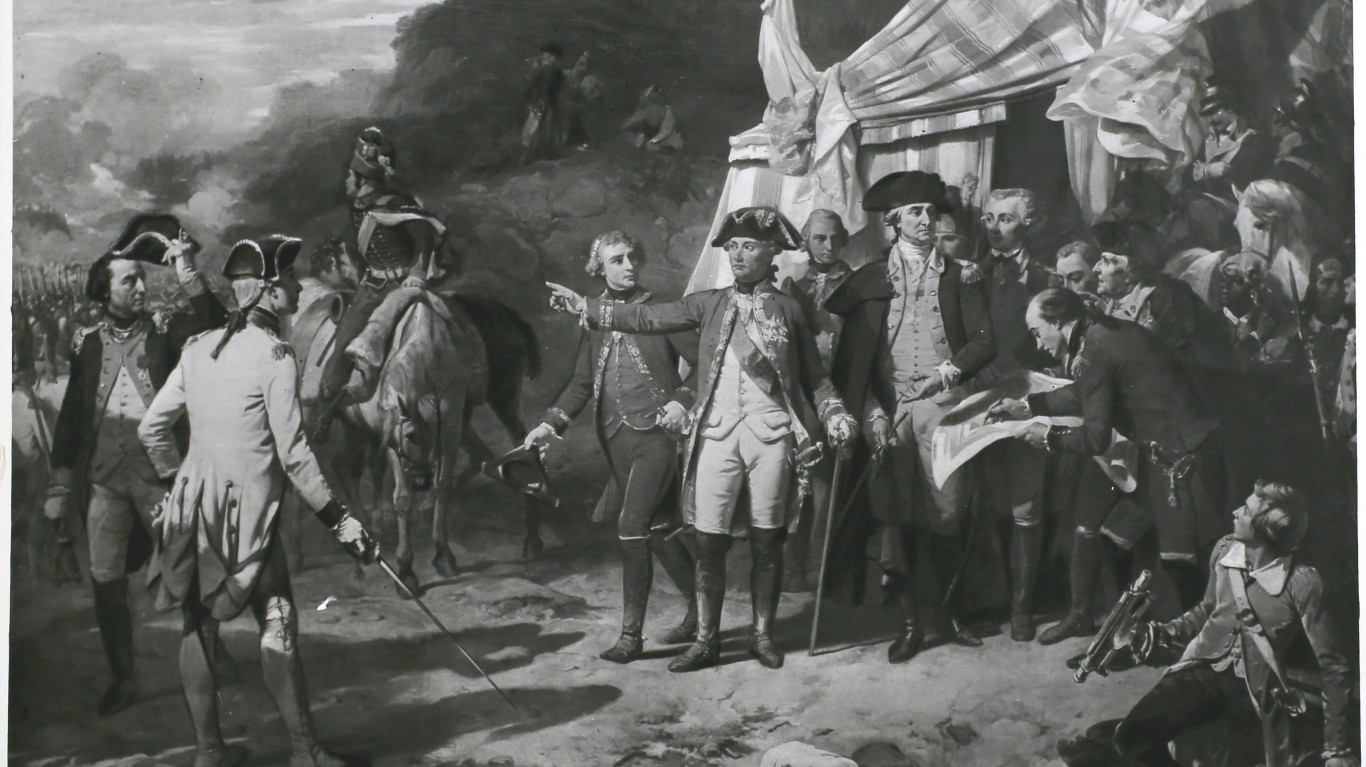 24/7 Wall St.
24/7 Wall St.